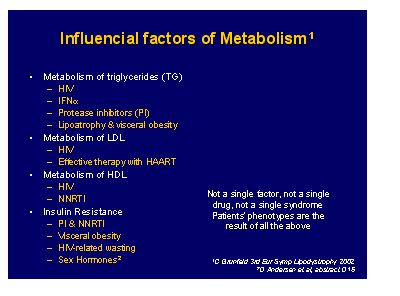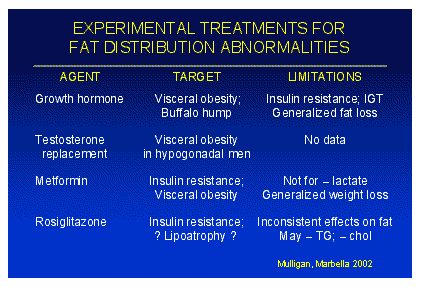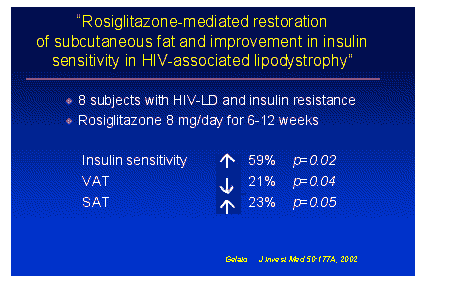 |
 |
 |
| |
Lipodystrophy Conference in Marbella, Spain
Reported for NATAP by Mike Youle, MD, Royal Free Hospital, London, UK
|
| |
| |
The sun-drenched coast of Spain at Marbella (at least what remains between the building sites) provided a commodious setting for the 3rd European Workshop on Lipodystrophy and Metabolic Disorders. Hosted once again by Thierry Saint-Marc and with the local help of Rosa Polo-Rodriguez the Scientific committee brought together an impressive international group of investigators with a strong Spanish representation. The themes were similar to past workshops with a focus on recent advances in knowledge throughout the spectrum of the subject but also dealt with practical approaches to the clinical problems which result from the metabolic and physical changes that occur and have made such workshops necessary.
Following George Griffin's welcoming message Carl Grunefeld from the Veterans Administration Medical Center in San Francisco provided and overview of HIV and metabolic disorders and the lessons learnt from antiretroviral medication and the influential factors on metabolism in HIV infected individuals. He commenced his talk with a description of all of the changes seen prior to the use of HIV treatments which included:
- TG increase
- HDL cholesterol decrease
- LDL decrease but LDLb increase
- VLDL increase
- Insulin sensitivity increases
- Insulin levels lower than in controls
- Glucose levels either stable or lower than in controls.
However post-HAART the picture altered: -
|
|
 |
| |
Lactate and NRTIs
Kaes Brinkman from the Netherlands reported an overall incidence rate of hyperlactataemia of 10/1000 patient-year in asymptomatic subjects of 8-35% where as symptomatic or lactic acidosis 7.3-14.5/1000 patient year.
Yves Gerard and co-workers from Tourcoing in France undertook a prospective ongoing observational study of hyperlactataemia (HL) defined as serum lactate >2mmol/L on two consecutive occasions [O-1]. Between September 1997 and February 2002 sixty-four subjects were identified with an overall incidence rate of 18.6/1000 treated patient years. Within dual NRTI-containing regimens, incidence rates were 49.4/1000 treated patient years for d4t/ddI, 24.2/1000 treated patient years for 3TC/d4T and 4.2/1000 treated patient years for d4T sparing regimens. For those with severe HL (serum lactate >5mmol/L) the rates were 2.9/1000 treated patient years and developed around 7-13 months from start of therapy. One subject died and the authors argued that physician awareness and monitoring of lactates around the 6-12 moths after starting treatment is advisable.
Evaluating Mitochondrial Toxicity by Oral Glucose Tolerance Test
ter Hofstedte and her group looked at whether the use of a glucose tolerance test was beneficial in assessing the risk of metabolic damage prior to significant clinical markers of mitochondrial damage [O-2]. Plasma glucose and lactate were measured at baseline and 60 minutes and 120 minutes after a standard 75g glucose-drink. 54 subjects were studied: 18 normal volunteers (Group 1), 9 HIV non-treated (Group 2), 15 subjects on HAART but with no symptoms (Group 3) and 12 with HAART and signs mitochondrial toxicity (Group 4). After testing no elevated lactates were seen in groups 1 or 2 whereas they were raised at all time points in Group 4 and at 60 minutes in 3/15 in Group 3. The authors suggested that an oral GTT could be used to determine early mitochondrial toxicity since in this study baseline lactate was only raised in 3/12 individuals.
NRTIs, Tryglicerides, and l-carnitine
Fromenty from the French laboratories of Inserm in Clichy discussed a study in fasted mice which showed that d4T and AZT could cause disturbance of fatty acid oxidation in the liver which was dose dependent [O-3]. At low drug levels (100mg/kg/day) liver triglyceride levels were decreased whereas the higher dose (500mg/kg/day) which is a level achieved in HIV treatment doses resulted in increased liver triglycerides. In addition the metabolism of ketone bodies was slowed resulting in a build up of these products of energy production. These changes were reversed by the addition of l-carnitine (200mg/kg/day) and appeared not to occur with non-thymidine based nucleoside analogues such as 3TC, ddI and ddC. The study suggests that d4T and AZT have specific effects on mitochondrial function in the liver with a stimulation of fatty acid metabolism leading to an exhaustion of the normal energy cycles which can be significantly reversed by using the amino acid carnitine.
Lipodystrophy: prevalence, risk factors, when does it occur
Ken Lichtenstein updated the HOPS cohort of 6167 patients followed since 1992. In two standardized evaluations 1064 patients were evaluated in 4th QTR 1998 and 1244 patients in the second survey conducted in 3rd QTR 2000, 546 patients participated in both surveys. He showed prevalence data at first evaluation of 13.2% with values at second evaluation of 23.8%. Risk factors for lipoatropy (patients with no lipoatropy at the first evaluation) were white race; age > 50 not significant although significant if CD4 < 500/mm3 and a clear influence of CD4 nadir.
There was a stronger relationship between severity of HIV infection (CD4) and lipodystrophy than with the duration of therapy, for all 3 classes of drugs. In addition there was also a stronger relationship between CD4 and all mitochondrial manifestations than with any therapy.
Massimo Galli of the Ospedale Luigi Facco, University of Milan, Italy showed fascinating data from four large Italian Cohorts. The first was the lipid sub-study of the pan-Italian ICONA cohort study of individuals on their first HAART regimen. In 827 subjects followed for 1737 patient years 12.8% [228] showed signs of lipodystrophy with 4.5% with pure fat loss, 5.4% fat accumulation and 2.6% representing mixed forms. In a multivariate analysis the most significant factor involved was the use of protease inhibitors (PI) with 2 nucleoside analogues (NNRTI) with a relative risk increase of 3.66 fold (p=0.007). In the cross-sectional cohort of 2258 subjects, 29% (282 women and 468 men) developed lipodystrophy with higher rates for all effects except isolated lipomas in the female subjects. The question of whether the tissue changes seem to change over time was graphically illustrated when he showed a series of photographs over time which revealed the gradual loss of facial fat with a slow increase in thickness of the neck to a "bull neck and finally a "buffalo hump". In the women's only cohort of 212 subjects followed prospectively over two years, 74 subjects developed lipodystrophic changes over year 1 and a further 43 over year 2. Breast size was much more variable and appeared to alter over time at odds with the other physical changes in some women, although this may reflect somewhat the difficulty in measuring breast size accurately.
Rosiglitazone
Kathy Mulligan from San Francisco General Hospital started the session on the Management of Long-term Complications with an excellent overview of the therapeutic options available for to reverse the signs of lipodystrophy.
|
|
 |
| |
She reviewed the studies on human growth hormone (very expensive but relatively effective, although can cause insulin resistance), testosterone replacement, metformin and glitazones, specifically rosiglitazone. Sutinen, who was present in the audience, had showed data at the last Retroviruses meeting that suggested that this agent was not beneficial in lipodystrophy and increased triglycerides significantly. She, however, showed data from Gelato et al. that noted in a small study that marked alterations in visceral and subcutaneous fat occurred in small number of subjects given this drug, suggesting further larger studies be warranted. The difference between the two studies were that the Gelato group CT scans were used whereas only DEXA scans and body measurements were used in the previous study which may be as accurate an assessment of central body fat which is a prime determinant of
cardiovascular risk.
|
|
 |
| |
Surgical Techniques in Facial Fat Wasting: Newfill, autologous fat transfer
There were a number of presentations on a variety of surgical techniques for the treatment of facial wasting and other fat wasting problem. Patrick Amard reviewed where the use of polylactic acid [Newfill] which is fast becoming the treatment of choice for facial atrophy in Europe. A restriction on its use in the US in a draconian way, by the FDA, has meant that access is extremely difficult there. However, the ease of use and excellent results obtained with this inert substance in Europe has been the major factor in this becoming the commonest treatment for facial fat atrophy. Amard commented on the need for it to be injected by a skilled dermatologist or plastic surgeon and that early use is associated with better final cosmetic results. He showed a technical film of injections being done highlighting the need to inject deeply, to use local anaesthetic mixed into the product and to establish a competent technique including multiple cross-hatched injections. The dual action of mechanical in-fill followed by a neocollagenosis three to four weeks late emphasizes the need to inform the patient that maximal effects of injections may not be realized until 4-8 weeks after the injections. A separate French group presented data on Coleman's technique of autologous fat transfer in 29 subjects treated from a cohort of 89 lipodystrophic patients. Of these 7 were women and 7 subjects had only facial wasting. There was a persistent benefit to the technique at 6 months as assessed by the physician and the patient in 72% (21) subjects whilst medium results occurred in 4 (13%) and bad or no result in 4 (13%) individuals. This method is of course reliant on having enough extra-facial to harvest and inject and the authors did point out that the combination of Coleman's technique and polylactic acid injections may be a better methodology.
Role of Sex Hormones in HIV & Lipodystrophy
The role of sex hormone changes in HIV disease and their replacement was reviewed by Mike Youle who showed the various forms of replacement that are available and the fact that improving testosterone levels by exogenous drug does not have detrimental effects on any area of HIV disease. The risk of increasing prostate cancer is not however clear. Ove Andersen and the group from Hvidovre Hospital presented a small interesting study that appeared to link hormonal changes with clinically apparent lipodystrophy. In 31 subjects [15 without signs of lipodystrophy and 16 with] they reviewed the effect of lipodystophy on free and total testosterone, oestrogen [O-15]. Sex hormone binding globulin which determines the amount of free testosterone available in the body and the pituitary hormones LH and FSH that centrally control sex hormone production were also measured. All markers showed a significant difference between the two groups and suggest a link between sex hormones and the physical changes of lipodystrophy opening up another for therapy for this syndrome. How much of these pertubations in levels are due to or the cause of lipodystrophy is unclear and will need prospective longitudinal studies to elucidate but it adds another layer to the complexity of the problem.
|
|
| |
|
 |
 |
|
|